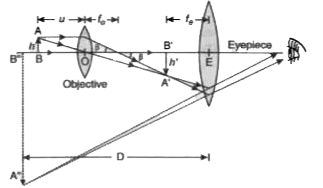Draw a ray diagram to show the working of a compound microscope . Deduce an expression for the total magnification when the final is formed at the near point .
In a compound microscope, an object is place at a distance of 1.5cm from the objective of focal length 1.25cm. If the eye piece has a focal length of 5cm and the final image is formed at the near point, estimate the magnifying power of the microscope. Solution in Kannada
Labelled Ray Diagram :

Expression for total magnification :
Magnification due to the objective ,
m0=h.h=Lf0
Magnification me, due to eyepiece , ( when the final image is formed at the near point )
me=(1+Dfe)
Total magnification,
m=m0me=Lf0(1+Dfe)
Estimation of magnifying power :
Given : u0=−1.5cm,f0=1.25cm,
we have
1f0=1v0−1u0
11.25=1v0−1−1.5⇒v0=7.5cm
m=v0u0(1+Dfe)
=7.5−1.5(1+255)⇒m=−30
Topper's Solved these Questions
- RAY OPTICS AND OPTICAL INSTRUMENTSBOOK - OSWAAL PUBLICATIONCHAPTER - RAY OPTICS AND OPTICAL INSTRUMENTSEXERCISE - TOPIC-3(Numerical Problems)
3 Videos
- RAY OPTICS AND OPTICAL INSTRUMENTSBOOK - OSWAAL PUBLICATIONCHAPTER - RAY OPTICS AND OPTICAL INSTRUMENTSEXERCISE - TOPIC-3(SHORT ANSWER TYPE QUESTIONS-II)
2 Videos
- NUCLEIBOOK - OSWAAL PUBLICATIONCHAPTER - NUCLEIEXERCISE - TOPIC -2 (Numerical Problems)
3 Videos
- Sample Paper 1BOOK - OSWAAL PUBLICATIONCHAPTER - Sample Paper 1EXERCISE - Exercise
36 Videos
Similar Questions
The total magnification produced by a compound microscope is 20. The magnification produced by the eye piece is 5. The microscope is focussed on a certain object. The distance between the objective and eyepiece is observed to be 14cm.
If the least distance of distinct vision is 20cm, calculate the focal length of the objective and the eye piece.
View SolutionDraw a labelled ray diagram showing the formation of a final image by a compound microscope at the least distance of distinct vision.
View SolutionThe half life of 38Sr90 isotope is 28 years. What is the rate of disintegration of 15 mg of this isotope? (Given Avogadro No =6.023×1023)
View SolutionCharges of 10μC and 15μC are separated by a certain distance. Which charge repels the other with a greater force?
View SolutionA compound microscope with an objective of 1.0 cm focal length and an eye piece of 2.0 cm focal length has a tube length of 20 cm . Calculate the magnifying power of microscope is final image is formed at the near point of eye.
View SolutionA compound microscope uses an objective lens of focal length 4cm and eye lens of focal length 10cm. An object is placed at 6cm from the objective lens. Calculate magnifying power of compound microscope if final image is formed at the near point. Also, calculate length of the tube of compound microscope.
View SolutionA compound microscope has a eyepiece of focal length 10m and an objective of focal length 4cm . Calculate the magnification if an object is kept at a distance of 5cm from the objective then final image is formed at the least distance of distinct vision.
View SolutionDraw a ray diagram to show the working of a compound microscope. Deduce an expression for the total magnification the final image is formed at the near point. In a compound microscope , an object is placed at a distance of 1.5 cm from the objective of focal length 1.25cm. if the eye piece has a focal length of 5 cm and the final image is formed at the near point, estimate the magnifying the power of the microscope.
View SolutionIn compound microscope the magnification is 95, and the distance of object from objective lens 1/3.8 cm and focal length of objective is ¼ cm. What is the magnification of eye pieces when final image is formed at least distance of distinct vision :
View SolutionThe length of the compound microscope is 14 cm. The magnifying power for relaxed eye is 25. If the focal length of eye lens is 5 cm, then the object distance for objective will be (in cm)
View SolutionA compound microscope with an objective of 1.0 cm focal length and an eyepiece of 2.0 cm focal length has a tube length of 20 cm. Calculate the magnifying power of the microscope, if the final image is formed at the near point of the eye.
View Solution(a) Draw a ray diagram to show the working of a compound microscope. Deduce an expression for the total magnification when the final image is formed at the near point. (b) In a compound microscope, an object is placed at a distance of 1.5 cm from the objective of focal length 1.25 cm. If the eyepiece has a focal length of 5 cm and the final image is formed at the near point, estimate the magnifying power of the microscope
View SolutionAn object is placed at a distance of 1.5 cm from the objective of focal length 1.25cm. if the eye piece has a focal length of 5 cm and the final image is formed at the near point, estimate the magnifying the power of the microscope.
View SolutionA compound microscope uses an objective lens of focal length 4 cm and eye lens of focal length 10 cm . An object is placed at 6 cm from the objective lens. Calculate magnifying power of compound microscope if final image is formed at the near point. Also, calculate length of the tube of compound microscope.
View SolutionThe length of a compound microscope is 14cm and its magnifying power when final image is formed at near point is 25. If the focal length of eyepiece is 5cm. The distance of object from the objective and the focal length of objective lens are
View Solution
